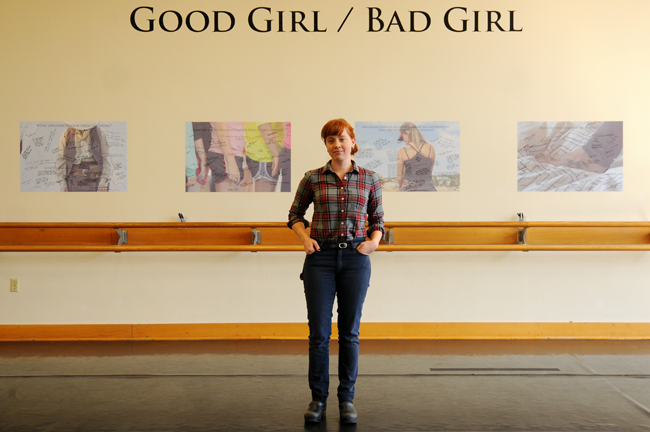What makes a bad girl, bad? Is it raunchy shorts, or an inability to conform to the status quo?
Kaitlyn Aylward, a Masters of Fine Arts candidate in costume design at UT, spent nearly 10 months traveling between New Mexico and Texas asking women of different ethnicities, ages and backgrounds, “What is a good girl? Bad girl?” Documenting her interviews through photography and recordings, Aylward compiled the responses into a Cohen New Works Festival exhibit “Good Girl/Bad Girl” that explores the different societal perceptions of dress.
Originally from New Mexico, Aylward chose to a focus on Native American, New Mexican, Mexican, Texan, cowgirl and sorority women. The photographs portray the every day reality of these women, from tending the land and relaxing in bedrooms covered with drawings of horses to laughing with friends dressed alike in traditional garb.
Sporting jeans and graphic tees, the younger generation of women dress to fit the norm. By pulling aside hair to reveal a hidden tattoo, or exposing wrists covered in beaded bracelets, each woman reveals a cherished part of her culture.
“The New Mexican and the Native American women talked about what was traditional dress and how to incorporate traditional dress into everyday clothing,” Aylward said. “And a lot of them said they were able to do that through accessories and through jewelry because often we see traditional as not appropriate for the every day world. They talked about how accessories were a way to bridge that with something more traditional, emblematic of their culture.”
The exhibit emphasizes the cultural differences of good girl/bad girl and appropriate dress through a series of recorded interviews playing throughout the room.
“[A good girl] would only take care of her horse first. Not worry about her belt, her boots, her fancy earrings, or any thing like that. Spend her money on her equipment. I mean we’re riding that dadgum horse, give me a break,” explained a member of the cowgirl culture in the exhibition. She echoed the sentiment that many working women shared: they dressed for comfort and functionality.
However, other interviewees delineated between good and bad based on sexuality and lifestyle. Aylward explained that often the first thing that comes to mind is the shallow perception of sexuality. Many commented that one’s promiscuity or perceived promiscuity distinguished whether you are a good girl or a bad girl.
“A good girl is a church-going girl who’s extremely conservative in her ways. She doesn’t drink, she doesn’t party, she doesn’t do any of that stuff. As far as wardrobe goes, she’s constantly covering up and wearing things that are church appropriate, you would say. The bad girl for me would be the chola, downtown chola,” said a member of the [Mexican] community in the exhibition.
Across all backgrounds, the most common delineation is modest dress versus showing more skin in suggestive places. However, the greatest difference in opinion stemmed not from different cultural backgrounds, but instead from age.
“The women who were in the over-forty bracket had a very specific way of looking at what was appropriate versus inappropriate versus the twenty and under. Especially for the New Mexican and the Mexican women, many grew up with more heavily religious influence than their children do nowadays,” Aylward said. “That influenced how they reacted and how they rebelled. They always did what was told; there was never an option to be a bad girl.”
Hoping to engage the audience in the discussion, Aylward included an interactive panel of photographs featuring questions like, “How do you describe the way you dress?” Viewers touring the exhibit are given markers and asked to respond on the pictures with their own perceptions of dress and sexuality.
“A lot of women said, ‘Well she’s either or a slut, or she’s a prude. She’s either conservative or risqué’,” Aylward said. “That was the first thing that most people went to because it’s probably the most present in all of our minds. But what I tried to do with these interviews is get a little bit deeper than that and learn about their history and their lives and why they had these ideas.”
Aylward forces the audience to reflect on their own standards of dress. The viewer must contend how he or she categorizes women, because ultimately, regardless of heritage or age, all women face imposed social norms. As “Good Girl/ Bad Girl” shows, the challenge of social stigmas bridges racial and cultural divides.




















